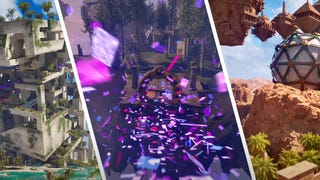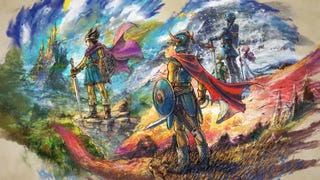After the launch of Diablo 4, I found out that Blizzard made a decision that was “against the ancestors”

A new recipe, but a familiar taste.Last weekend, the much-anticipated Diablo 4 finally began its final round of player testing before going on sale (the 18th was a pre-order internal test, and the 25th was a public test).The beta, which lasted for three days, revealed the entirety of Diablo 4’s prologue and first chapter, with only three regular professions – Sorcerer, Rogue and Barbarian – and a maximum level of 25.Frankly speaking, the beta experience of Diablo 4 exceeded my expectations and can almost be considered as a masterpiece of the series. Not only does it inherit the violent aesthetics of Diablo 2, but it also retains and improves upon the combat framework of Diablo 3, with a much more selective skill set.
It is also worth mentioning that Diablo 4, the first sequel to the series to include a large open world map, incorporates many of the gameplay features of MMORPGs, allowing players to group and socialise more easily. However, this has also led many veterans to criticise Blizzard for making a decision that is “against their ancestors”.
As the game changes from single player to online, and from single player exploration to multiplayer online, it’s clear that much of the gameplay is designed for multiplayer, and that Diablo 4, which is becoming more and more “Warcraft”, will become an online game that requires you to “clock in” every day. Whether Diablo 4 will become an online game that requires you to clock in and out every day, and whether Diablo 4, with its complete abandonment of the single player experience, will bring back the “familiar flavour” to veteran players, are questions that will be faced in the future.
01Is it starting? It’s over!
As has become an old tradition in Blizzard’s playtesting, it’s become commonplace to have problems on launch day, and I was “shut out” in the early hours of the 18th, facing the login screen for nearly 10 minutes and trying a dozen times. After a dozen attempts, I finally decided that the odds were that Blizzard’s ancestral servers had “smoked” again.
After changing the accelerator, the login screen finally appeared, but what I didn’t expect was that Blizzard, the old man, did not speak of martial arts, and made a move to “spend days like years”, which originally only took 3 minutes to queue up the list, and waited for 15 minutes but did not enter, after exiting and trying again, the queue list skyrocketed to 10 minutes, in the matter of players breaking the defense I have to admit that Blizzard is definitely a professional.
After another 30 minutes of patience, the game officially began to pinch the face. Diablo 4 not only allows you to choose your gender (fortunately you only see 2, Diablo is spared from this aspect of ZZZQ for now), but you can also “fine-tune” your character’s appearance. I think the word “fine-tuning” is accurate enough, as there are basically no more than 10 areas for each character to adjust, not even as many as in World of Warcraft 10 years ago.
After watching the opening CG and entering the game, I thought Blizzard would have run out of steam, but he backhanded me with a “broken” shot. The first game scene, the character loaded for 5 minutes delayed to appear, wait for the appearance began to float around the whole map, skills never catch up with the speed of the attack, see the snow wolf monster attacked 2.3 seconds before the body began to twist hard, repeatedly suffer from delayed attacks, I finally decided to give up, let them go is also to let themselves go.
So the first round of the first test ended in failure due to Blizzard’s “obstruction”.
02The same Blizzard Studios.
It’s a good thing that Blizzard finally realised that they are a game company and not just a Blizzard studio, and a quick server rescue finally made logging in for the afternoon less of a chore and allowed me to get a glimpse of what Diablo 4 has to offer.
The opening CG animation shows that Blizzard has really gone to town on Diablo 4, setting the tone for a dark, realistic and bloody game.
This change is also reflected in the game’s storyline transitions, and it is clear that the storyline will be the main focus of this game. Compared to the usual stand-up dialogue of previous works, Diablo 4 adds large sections of main-view transitions (most likely rendered in real time) to set the scene or portray the character’s personality, and various cinematic language is also at hand to deepen the player’s experience from multiple perspectives. The filmic language is also used to deepen the player’s experience from multiple perspectives.
In particular, I was impressed by the hospitality of the villagers in the prologue, when the villagers pull their carts in a snowstorm, humming an old song, and the poetic captions appear on the right side of the screen, giving me that weird feeling of being from a cult.
In addition, Blizzard has given the game a “graphic” feel. On the one hand, the transitions, apart from driving the plot, focus heavily on the characters and scenes in the game, such as Lilith’s gorgeous face appearing frequently and Archangel Inaris descending like a saviour. Thanks to the excellent character modelling, most of the characters in Diablo 4 become “flesh and blood” and continue to imprint themselves on the player’s memory.
On the other hand, Blizzard has also included a number of close-ups for some of the special scenes, especially the shift from a top-down to a first-view perspective, which gives the game a grand and mysterious artistic quality that it did not have before.
Of course, the actual graphics have also been significantly ‘refurbished’. Both in terms of lighting and mapping, Diablo 4 is one of the best in the top-down genre, especially when you enter the very different dungeons, and the unique art style almost instantly gives the player a little bit of a “Diablo” feel.
I can say that it didn’t take long for me to feel the familiar “Diablo flavor” that Diablo 4 exudes from the inside out, and it’s this familiarity that could take this game to unprecedented heights.
03A familiar flavour, on purpose.
Diablo 4 has also made a number of changes to the design of the map compared to its predecessor. The originally separated 5 areas have been consolidated into one oversized open world map, where you can see almost all the information explored in the current area at a glance, except for the dungeons.
To enhance the exploration experience, Diablo 4 incorporates exploration into the area reputation, whether it’s finding a teleportation point, discovering an area or completing a side quest to explore a side dungeon, players will be able to earn a certain amount of exploration reputation and unlock the corresponding rewards through exploration reputation points. The first map in the beta, Shattered Peaks, already offers 35 side quests, 77 areas to explore and 23 dungeons.
It is worth mentioning that the new Lilith Altars are located all over the area and players only need to click on them to get the corresponding rewards, such as attribute point boosts and skill point boosts, and these rewards are shared by all accounts, so it is foreseeable that when the game goes live, finding all the Lilith Altars first may be a must for new players.
For many players are more concerned about the combat design and gameplay, I would like to talk about it divided into two aspects: skills and equipment.
In terms of skills, Diablo 4 inherits the framework of its predecessor, still 1 basic 1 core 4 active skills configuration, players get resources through basic skills, and then consume resources through core skills to hit output, which is the basic combat logic of the game.
However, unlike its predecessor, this game has made a radical change in the variety of skills to choose from. Firstly, the game offers 6 skill categories, taking the mage I play as an example, they are divided into basic, core, control, summoning, defence and ultimate, each category offers 3 to 5 different attributes of skills to choose from, players need to spend a certain amount of skill points in the previous skill category to unlock the next category, that is to say, these skill categories are constantly unlocked along with the player’s upgrade process.
There is no restriction on the choice of skills in any category except for the final ultimate skill, so if you are confident enough, you can play the world with 4 basic skills. Active skills can generally be added 5 times, followed by enhanced skills and skill branches, most of which will provide additional skill gain effects and can only be chosen from two.
In addition to the six active skill categories mentioned above, there are also three elemental ultimate passive skills available at the end of the game, which are also available in each branch, but due to the limitation of skill points in this test, the ultimate passive skills are not available, so I won’t go into too much detail here.
It is easy to see that there is almost no difference in operation between this game and its predecessor. The new dodge skill, as far as I can see from my experience as a mage, does not bring any improvement in mobility, but is more like a life-saving skill when you are surrounded by enemies, so that you can jump out of the pile of monsters to avoid the tragedy of being surrounded and killed.
It is worth mentioning that Diablo 4 differentiates the attributes of the professions, and each profession can open up special passive skills after level 15. Take mages for example, level 15 and 30 can unlock 2 enchanted skill bars, and through the enchanted gain of active skills, they can enjoy 2 unique special passive skills at the same time.
The biggest change in terms of equipment is that the number of pieces of equipment that players can wear has been greatly reduced, from 13 pieces in the previous game to 10 pieces today. However, the good news is that the amount of equipment in this game is the same as in the second generation, which is a worthy tribute to the classics.
In terms of item levels, the dark gold gear from Generation 2 is back, offering powerful affixes and unique equipment, but it only drops on difficulty 3 and 4 after passing the level, so it’s not available for this test. The Ancient quality also remains, but is still exclusive to difficulty 3.4.
The green set has not yet been added to the game, so there is no telling how strong it will be. However, early on, the development team stressed the need to strengthen the bulk of the pieces, and we can now get a small glimpse of that with this test.
On the one hand, all rare yellow gear can be inscribed with Might (aka the traditional legendary wording, which is called Might in this game). Apart from having one less attribute wording than legendary gear, what is known is that some rare yellow gear will provide an additional gear attribute, such as trousers that will provide a healing gain from potions, which will greatly increase the usefulness of yellow gear.
On the other hand, there are two ways to obtain Might in this game, one is fixed after defeating a boss in a dungeon, and the other is direct extraction from legendary equipment. It is important to note that the dungeon power is more like a collector’s item and can be used infinitely once acquired, while the power extracted from equipment is in the form of an item that can only be inscribed once and has different value bonuses for different parts.
From the experience so far, the same kind of power, the value of equipment extraction has a chance to be greater than the power obtained from the dungeon, which means that the power value of the equipment will be better, and the equipment power will have unique skills exclusive, such as the Hydra skill wording, which can only be obtained from legendary equipment.
As you can see, Diablo 4 combines the equipment system of Generation 2 and the skill system of Generation 3. There is not much innovation, but for veteran players, this is probably the taste to play.
In addition, the large map design also leads to the disappearance of the classic random map exploration, and the design of the dungeons seems too mediocre, with the intricate and sinister environment gone, either looking for keys or collecting evil energy, with a face full of flattery that says I’m here to serve the great secret world.
Of course, none of the above MMO-style design and gameplay is the focus of Diablo 4. At least in the current experience, it’s only the icing on the cake after the core swipe and go gameplay. It’s safe to say that the core experience for players in the later stages of the game will continue to revolve around how to mix and match BDs and challenge higher difficulties, with the big mystery levels and so on, while the perception of the multiplayer experience will probably vary from person to person.
Hopefully, Diablo 4 will at least be adjusted for multiplayer once it’s officially released. After all, it’s on PC and console, not mobile, so I sincerely hope Blizzard will come to their senses, after all, the “don’t you have a phone?




